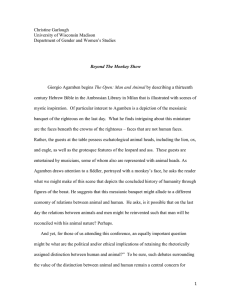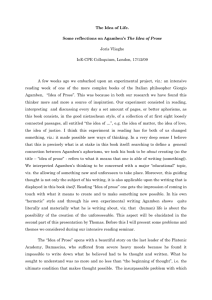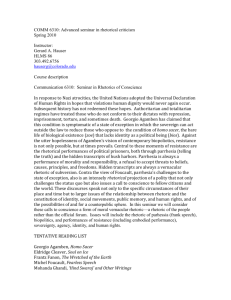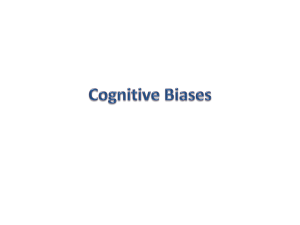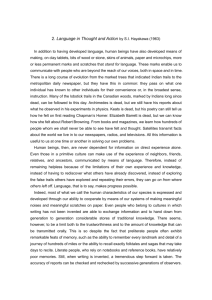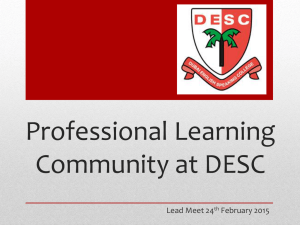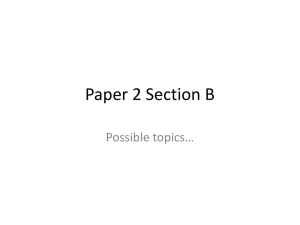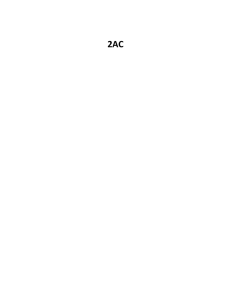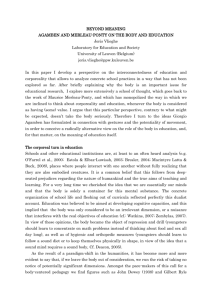Bell and Russell 2K - openCaselist 2015-16
advertisement
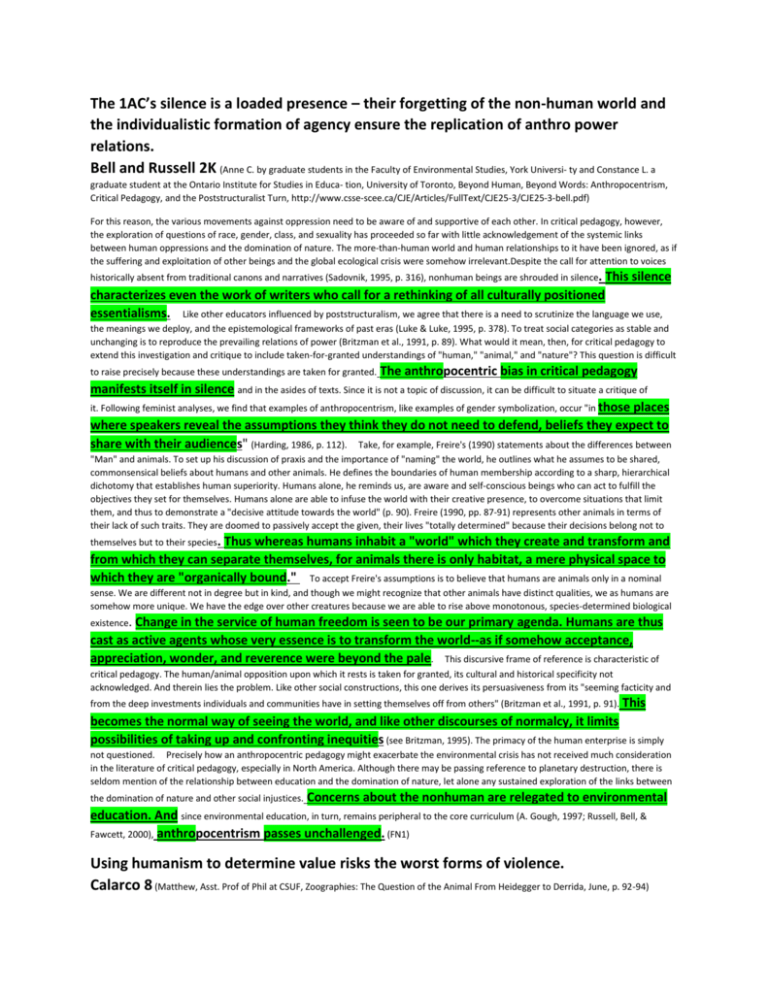
The 1AC’s silence is a loaded presence – their forgetting of the non-human world and the individualistic formation of agency ensure the replication of anthro power relations. Bell and Russell 2K (Anne C. by graduate students in the Faculty of Environmental Studies, York Universi- ty and Constance L. a graduate student at the Ontario Institute for Studies in Educa- tion, University of Toronto, Beyond Human, Beyond Words: Anthropocentrism, Critical Pedagogy, and the Poststructuralist Turn, http://www.csse-scee.ca/CJE/Articles/FullText/CJE25-3/CJE25-3-bell.pdf) For this reason, the various movements against oppression need to be aware of and supportive of each other. In critical pedagogy, however, the exploration of questions of race, gender, class, and sexuality has proceeded so far with little acknowledgement of the systemic links between human oppressions and the domination of nature. The more-than-human world and human relationships to it have been ignored, as if the suffering and exploitation of other beings and the global ecological crisis were somehow irrelevant.Despite the call for attention to voices historically absent from traditional canons and narratives (Sadovnik, 1995, p. 316), nonhuman beings are shrouded in silence. This silence characterizes even the work of writers who call for a rethinking of all culturally positioned essentialisms. Like other educators influenced by poststructuralism, we agree that there is a need to scrutinize the language we use, the meanings we deploy, and the epistemological frameworks of past eras (Luke & Luke, 1995, p. 378). To treat social categories as stable and unchanging is to reproduce the prevailing relations of power (Britzman et al., 1991, p. 89). What would it mean, then, for critical pedagogy to extend this investigation and critique to include taken-for-granted understandings of "human," "animal," and "nature"? This question is difficult to raise precisely because these understandings are taken for granted. The anthropocentric bias in critical pedagogy manifests itself in silence and in the asides of texts. Since it is not a topic of discussion, it can be difficult to situate a critique of it. Following feminist analyses, we find that examples of anthropocentrism, like examples of gender symbolization, occur "in those places where speakers reveal the assumptions they think they do not need to defend, beliefs they expect to share with their audiences" (Harding, 1986, p. 112). Take, for example, Freire's (1990) statements about the differences between "Man" and animals. To set up his discussion of praxis and the importance of "naming" the world, he outlines what he assumes to be shared, commonsensical beliefs about humans and other animals. He defines the boundaries of human membership according to a sharp, hierarchical dichotomy that establishes human superiority. Humans alone, he reminds us, are aware and self-conscious beings who can act to fulfill the objectives they set for themselves. Humans alone are able to infuse the world with their creative presence, to overcome situations that limit them, and thus to demonstrate a "decisive attitude towards the world" (p. 90). Freire (1990, pp. 87-91) represents other animals in terms of their lack of such traits. They are doomed to passively accept the given, their lives "totally determined" because their decisions belong not to themselves but to their species. Thus whereas humans inhabit a "world" which they create and transform and from which they can separate themselves, for animals there is only habitat, a mere physical space to which they are "organically bound." To accept Freire's assumptions is to believe that humans are animals only in a nominal sense. We are different not in degree but in kind, and though we might recognize that other animals have distinct qualities, we as humans are somehow more unique. We have the edge over other creatures because we are able to rise above monotonous, species-determined biological existence. Change in the service of human freedom is seen to be our primary agenda. Humans are thus cast as active agents whose very essence is to transform the world--as if somehow acceptance, appreciation, wonder, and reverence were beyond the pale. This discursive frame of reference is characteristic of critical pedagogy. The human/animal opposition upon which it rests is taken for granted, its cultural and historical specificity not acknowledged. And therein lies the problem. Like other social constructions, this one derives its persuasiveness from its "seeming facticity and from the deep investments individuals and communities have in setting themselves off from others" (Britzman et al., 1991, p. 91). This becomes the normal way of seeing the world, and like other discourses of normalcy, it limits possibilities of taking up and confronting inequities (see Britzman, 1995). The primacy of the human enterprise is simply not questioned. Precisely how an anthropocentric pedagogy might exacerbate the environmental crisis has not received much consideration in the literature of critical pedagogy, especially in North America. Although there may be passing reference to planetary destruction, there is seldom mention of the relationship between education and the domination of nature, let alone any sustained exploration of the links between the domination of nature and other social injustices. Concerns about the nonhuman are relegated to environmental education. And since environmental education, in turn, remains peripheral to the core curriculum (A. Gough, 1997; Russell, Bell, & Fawcett, 2000), anthropocentrism passes unchallenged. (FN1) Using humanism to determine value risks the worst forms of violence. Calarco 8 (Matthew, Asst. Prof of Phil at CSUF, Zoographies: The Question of the Animal From Heidegger to Derrida, June, p. 92-94) Agamben gives the name “anthropological machine” (a concept he borrows from the Italian scholar of myth Furio Jesi) to the mechanism underlying our current means of determining the human-animal distinction. This machine can best be understood as the symbolic and material mechanisms at work in various scientific and philosophical discourses that classify and distinguish humans and animals through a dual process of inclusion and exclusion. The first chapters of The Open provide the reader with a fascinating overview of some of the historical variations on the anthropological machine at work in a number of authors and discourses, ranging from the philosophy of Georges Bataille and Alexandre Kojeve to the taxonomic studies of Carl Linnaeus and post-Darwinian paleontology. For the purposes of the argument I am developing here, it will suffice to recall the general structure of the machine and why Agamben argues that it is necessary to stop its functioning. Agamben makes a distinction between two key variations on the anthropological The modern anthropological machine is post-Darwinian. It seeks to understand, following the principles of natural science, the emergence of the fully constituted human being from out of the order of the human animal (the latter, of course, is in many ways indistinguishable from certain nonhuman animals, especially so-called higher machine: the modern and premodern. primates). In order to mark this transition, it is necessary to determine and isolate the animal aspects of the human animal and exclude them from humanity proper. Agamben describes this process as involving an “animalization” of certain modes of human life, an attempt to separate out—within human beings themselves—what precisely is animal, on the one hand, and human, on the other. This variation on the anthropological machine gives rise to the search by nineteenth-century paleontologists for the “missing link” that provides the biological transition from speechless ape to speaking human. But it also opens the way for the totalitarian and democratic experiments on and around human nature that function by excluding animal life from human life within human beings. Agamben suggests that “it is enough to move our field of research ahead a few decades, and instead of this innocuous paleontological find we will have the Jew, that is, the non-man produced within the man, or the neomort and the overcomatose person, that is, The premodern form of the anthropological machine, which runs from Aristotle up through Linnaeus, functions in a similar but inverted form. Rather than animalizing certain aspects of the human, animal life is itself humanized. Human beings who take an essentially animal form are used to mark the constitutive outside of humanity proper: the infant savage, the wolf-man, the werewolf, the slave, or the barbarian. Here, the beings situated at the limits of humanity suffer similar consequences to those “animalized” beings caught within the the animal separated within the human body itself” (O, 37). working of the modern anthropological machine. As Agamben suggests, the structure or machine that delimits the contours of the human is perfectly ironic and empty. It does not function by uncovering a uniquely human trait that demarcates a clean break between human and all other nonhuman animals—for, as Agamben himself acknowledges, no such trait or group of traits is to be found. This much we know from current debates in evolutionary biology and animal ethics. And here it is not so much a matter or subscribing to a watereddown, quasi-Darwinian continuism that would blur any and all distinctions one might wish to make between and among human and nonhuman animals but rather recognizing that deciding what constitutes “the human” and “the animal” is never simply a neutral scientific or ontological matter. Indeed, one of the chief merits of The Open is that it helps us to see that the locus and stakes of the human-animal distinction are almost always deeply political and ethical. For not only does the distinction create the opening for the exploitation of nonhuman animals and others considered not fully human (this is the point that is forcefully made by animal ethicists), but it also creates the conditions for contemporary biopolitics, in which more and more of the “biological” and “animal” aspects of human life are brought under the purview of the State and the juridical order. As Agamben has argued in Homo Sacer and elsewhere, contemporary biopolitics, whether it manifests itself in totalitarian or democratic form, contains within it the virtual possibility of concentration camps and other violent means of producing and controlling bare life. It comes as no surprise, then, that he does not seek to articulate a more precise, more empirical, or less dogmatic determination of the human-animal distinction. Such a distinction would only redraw the lines of the “object” of biopolitics and further define the scope of its reach. Thus, instead of drawing a new human-animal distinction, Agamben insist that the distinction must be abolished altogether, and along with it the anthropological machine that produces the distinction. Recalling the political consequences that have followed from the modern and premodern separation of “human” and “animal” within human existence, Agamben characterizes the task for thought in the following terms: “it is not so much a matter of asking which of the two machines [ie, the modern or premodern anthropological machine]…is better or more effective—or, rather, less lethal and bloody—as it is of understanding how they work so that we might eventually, be able to stop them” (O, 38). Vote negative to reject their human based pedagogy. We affirm an animist research method – this is a process of bringing the voices of the non-human into the interpretation of research and teaching. Barrett 11—M.J., University of Saskatchewan, Canada, Doing Animist Research in Academia: A Methodological Framework, Canadian Journal of Environmental Education Vol 16, 2011, http://cjee.lakeheadu.ca/index.php/cjee/article/viewFile/957/635, Shree Use Forms of Re-Presentation That Enable Both Researcher and Reader to Make Meaning Through Rather Than Just About an Animist Ontology “form mediates understanding … [and] nontraditional form helps disrupt the hegemony inherent in traditional texts and evoke emotional [and other] responses that bring the reader/viewer closer to the work, permitting otherwise silenced voices to be heard” (p. 232, cited in Nolan, in press). Engaging animism is not exclusive of, but necessitates moving beyond, intellectual knowing. It entails disrupting the privileged place of linear thought and creating meditative spaces where the “voices” of other-than-human “persons” (in their many forms) can be heard. While it is often suggested that a participatory consciousness emerges from direct contact with the natural world (Bai, 2009), my experiences suggest this is not necessarily always the case: communications from other-than-human “persons” can, and often do, transcend time and space in ways that can influence both the designer and reader of the hypertext. The combination of intuitively placed links, music, “thought-bits” and image, together with the multi-linear hypertextual form (Morgan, 2000) reflects many of Butler-Kisber (2002) notes that the ways of coming to know that were used in the development of this research and a dialogic method(ology). Supported by the longer theoretical sections, they encourage reading through the reader’s experience of travelling through the hypertext, and integrating multiple knowledge forms during his or her wanderings through it, provide an experiential medium designed to mirror, as best as possible, many of the methods used to complete the research. In the process of selecting the links, the hand and eye are drawn to the places of resonance between the individual’s meaningmaking process and the content.¶ This research is not exclusive of intellectual knowing, but stretches the reader to move beyond it. In doing so, the representation creates multiple opportunities for other-than-human persons to interrupt human thinking and knowing. It is up to the reader to be a reciprocating partner in this engagement. The interruptive nature of the format unsettles reliance on extended explanations, which can risk reinscribing “clichéd and explanatory language” (Davies, 2000b, p. 252) and logic as privileged. In its place, I foreground porosity, a trans-rational form of knowing that supports understandings of multiple knowledge systems. In other words, opportunities to engage a re-animated perception (Bai, 2009) and support readers in an experience of meaning-making through an animist ontology. The format for the dissertation was ultimately determined as I “unconsciously” walked patterns in the snow, and ran the cul-de-sacs in my neighbourhood. My footprints mapped out the loops, dead-ends, and constant webbing a hypertext would allow. As a technoneophyte, I have to admit that I was rather distraught when I realized that my body’s mapping seemed to be indicating that a web-based format was most the hypertext, somewhat ironically, offers a medium through which the dominant role humans have afforded themselves as the sole agents in research and its many processes can be disrupted.¶ Artist Lipsett (2010) speaks of the importance of letting go of fear and trusting one’s creative processes as a means of establishing “deep and lasting even transformative Nature connections” (p. 7). Bai (2009) refers to the significance of overcoming “humanity’s inability to perceive and feel the intrinsic worth of the other—in this case, nonhuman beings” (p. 135). Abram (1996) talks about limitations of the alphabet and phonetic language, and the ways in which it has disconnected us from an animate earth. Attending to dreams, visions, appropriate for the dissertation. Yet despite its reliance on technology, serendipity, embodied knowing, and spontaneous intuitions are also important ways to move beyond what Berry (1988) refers to as human autism to the many voices of the natural world (Berry, 1988). These are all involved in a dialogic method(ology).¶ A dialogic method(ology) has many parallels with intuitive (Anderson, 2004; in press) and organic inquiry (Clements, 2004), which, as of 2004, has “been used, in some form, in at least 86 dissertations in at least 17 graduate schools” (Braud, 2004, p. 18). Rather than focusing on any specific methods, organic inquiry is described instead as “an approach” that is premised on a pre-existing “psychological and spiritual preparation and adequateness … of the researcher, and the importance of the active use of transpersonally-relevant resources” (Braud, 2004, p. 18). It draws heavily on “transpersonal and spiritual resources” the researcher brings to the process. Intuitive inquiry has been developed to the level of specific methods in its most recent iteration, and although Anderson recognizes “nature” as having a potentially significant role in a researcher’s process, it is not foregrounded A dialogic method(ology) is more explicit in its recognition and description of methods for engaging other-than-human “persons” in the transfer of knowledge, as well as providing a method for clearing obstructing discourses the researcher may encounter as he or she works to engage the methods (see Zajonc, 2009 for a somewhat different approach that places earth at the centre of inquiry). A dialogic method(ology) is also unique in some of its forms of representation, which deliberately create spaces for readers’ intuitive engagement with other-than-human “persons” as contributors to research, and thus, to knowledge creation. in her published work.
